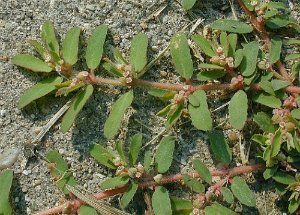Description: Spotted Spurge, scientifically known as Euphorbia humistrata, is an annual, low-growing herbaceous plant belonging to the Euphorbiaceae family. It is native to North America and is commonly found in gardens, lawns, and disturbed areas. Spotted Spurge is characterized by its prostrate growth habit, small green leaves with reddish spots, and the milky sap produced when its stems are broken.
Habitat and Distribution: Spotted Spurge thrives in open, sunny areas, and it is often found in lawns, gardens, sidewalks, and other disturbed sites. It is well-adapted to a variety of soil types and can tolerate dry conditions. Due to its ability to spread rapidly, Spotted Spurge is considered a common and troublesome weed in many landscapes.
Physical Features:
- Leaves: The leaves of Spotted Spurge are oval to elliptical, small in size, and have reddish spots in the center. The arrangement is opposite, and the leaves are arranged along reddish stems.
- Flowers: Inconspicuous flowers are surrounded by small, leaf-like structures called bracts. The entire plant exudes a milky, white latex sap when damaged.
Ecological Impact:
Spotted Spurge can have both positive and negative ecological impacts:
- Wildlife Habitat: The plant provides shelter for small insects and can be a food source for some herbivorous insects.
- Competitive Weed: In cultivated areas, Spotted Spurge can outcompete desirable plants and negatively impact the aesthetics of lawns and gardens.
Control and Management:
- Healthy Turf: Maintaining a healthy and dense lawn through proper watering, fertilization, and mowing can help suppress the growth of Spotted Spurge.
- Mulching: Applying a layer of mulch in garden beds can help prevent Spotted Spurge from establishing by blocking sunlight and reducing soil temperature.
- Hand Pulling: Hand pulling Spotted Spurge is effective for small infestations. Be sure to remove the entire plant, including the roots, to prevent regrowth.
- Chemical Control: Pre-Emergent Herbicides: Applying pre-emergent herbicides in the spring can help prevent the germination of Spotted Spurge seeds.
- Post-Emergent Herbicides: Selective post-emergent herbicides labeled for broadleaf weed control can be applied to actively growing Spotted Spurge. Follow label instructions carefully.
Preventing Spread:
- Early Detection: Regularly inspecting lawns and gardens for signs of Spotted Spurge is crucial for early detection. Prompt removal or control measures can prevent its spread.
- Limiting Soil Disturbance: Minimizing soil disturbance in areas where Spotted Spurge is prevalent can help reduce the germination of seeds and the spread of the plant.
- Proper Disposal: Ensuring proper disposal of plant material containing Spotted Spurge seeds can prevent unintentional spread to new areas.
In conclusion, managing Spotted Spurge requires a combination of cultural practices, mechanical control, and, if necessary, targeted herbicide application. Early detection and prevention measures are essential to minimize its impact on lawns, gardens, and other cultivated areas.



